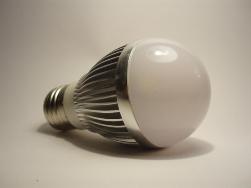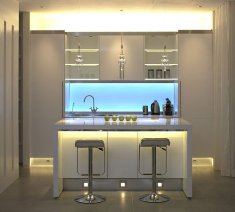Categories: Featured Articles » Sources of light
Number of views: 64458
Comments on the article: 24
Baby Disease LED Lighting
 After a shaft of optimistic forecasts about the imminent crowding out of incandescent LEDs, there was a lull. The first samples of LED lamps did not cause delight, but rather bewilderment. Are these pathetic, blinding eyes sources of light designed to replace the usual light bulbs with filament?
After a shaft of optimistic forecasts about the imminent crowding out of incandescent LEDs, there was a lull. The first samples of LED lamps did not cause delight, but rather bewilderment. Are these pathetic, blinding eyes sources of light designed to replace the usual light bulbs with filament?
Let's try to answer this, and several other questions. The advent of blue LEDs in 1998 paved the way for solid-state white light sources. After that, the scope of LEDs began to expand rapidly: from the traditional illumination of dashboards to the replacement of fluorescent lamps in televisions and monitors with LCD panels.
But the impressive progress of semiconductor sources has not affected household lighting. According to one version, LED lamp too expensive, so they are not popular with buyers. We will try to figure out whether this reason alone inhibits the demand for the latest light sources.
 Variety of designs led bulbs It does not reflect the popularity of the source in domestic applications, but rather, attempts to overcome the difficulties that lighting engineering encountered in introducing solid-state light sources.
Variety of designs led bulbs It does not reflect the popularity of the source in domestic applications, but rather, attempts to overcome the difficulties that lighting engineering encountered in introducing solid-state light sources.
These difficulties are associated with the peculiarities of LEDs: they are “truly” point sources and emit light in a narrow solid (spatial) angle with a brightness comparable to the arc of a welding machine.
Before that, we were dealing with lamps that shine in a wide solid angle close to 360 degrees. In luminaires, due to various tricks, the luminous flux of the lamps is redistributed in the right direction, while 20-25% of the light is lost.
The blinding effect of the "point" filaments is suppressed by the use of diffusers, which, in turn, again "take" part of the light flux. This was the case before the advent of LEDs.
LEDs have a radiant area of a semiconductor junction that is really point-like, with micron sizes. After collecting the radiation with internal optical elements, we get an unusual picture of a bright, blinding source with a narrow, similar to a chamomile petal, pattern of light emission. It has not yet been possible to expand it to obtain the usual distribution of light flux without serious losses.
 Another problem of LEDs, especially powerful ones, is the degradation of the emitting crystal with increasing temperature. Reading about the fantastic lifespan of LED lamps, one wonders at the craftiness of sellers. They indicate the values that are obtained when testing LEDs in the laboratories of the manufacturer, at a fixed crystal temperature.
Another problem of LEDs, especially powerful ones, is the degradation of the emitting crystal with increasing temperature. Reading about the fantastic lifespan of LED lamps, one wonders at the craftiness of sellers. They indicate the values that are obtained when testing LEDs in the laboratories of the manufacturer, at a fixed crystal temperature.
Under these conditions, the service life is really up to 100 thousand hours or more. In general, if it was possible to maintain the temperature of the semiconductor junction at subzero temperatures, then the LEDs worked “forever”.
In practice, in high-power diodes, the transition temperature can reach 100-120 degrees, while the dopants due to diffusion “leave” the transition zone and the light flux, which means that the efficiency drops sharply.
High-power LEDs with currents above 100 mA require special power devices that “rigidly” support the nominal value of the current through the diode. Deviation of the operating current in either direction dramatically reduces the efficiency of the LED, and excess is fraught with failure of the emitting crystal.
Now about the service life. For lamps with a group, series connection of diodes, the reliability decreases in proportion to the number of diodes. With several dozens of elements, it is not necessary to expect a service life of more than 5-10 thousand hours.
Powerful LEDs last longer, up to 50 thousand hours.But they require the use of a special power supply: a single or multi-channel driver (AC to DC converter with stabilization). A bulky heatsink is also needed to remove heat. Therefore, such lamps are much more expensive.
What do we have in practice? Unusual light, uneven lighting of the room with bright spots in one place and shadows in another - these are the most harmless consequences of replacing traditional lamps with LED ones. It immediately becomes apparent that the power of solid-state sources to get the usual lighting is not enough. Need more powerful LED lamps. But they will also look like foreign strangers, creating the same unevenness of lighting.
 Is there a way out of this deadlock? Of course there is! For this, the end consumer should not be offered a separate lamp, but a lamp-lamp kit, in which the lighting parameters of new light sources are optimized for the usual lighting environment of the rooms. You can already offer several solutions today.
Is there a way out of this deadlock? Of course there is! For this, the end consumer should not be offered a separate lamp, but a lamp-lamp kit, in which the lighting parameters of new light sources are optimized for the usual lighting environment of the rooms. You can already offer several solutions today.
The first of these is the use of optical fibers. Once popular lighting systems, in recent years they have practically not been used due to the difficulty of focusing and introducing light into the systems. But LEDs are ideal for such distributed lighting systems. A narrow luminous flux introduced from the ends is scattered along the length of the fiber, providing soft, even illumination of the room. In this case, the glare of the LEDs is completely eliminated.
Modern materials used for strip (linear) systems of decorative LED lighting type duralight, may well become the basis for fixtures of an unusual shape with acceptable power.
An ordinary disk made of suitable polymer material, with modern LEDs placed on the rim (an analogue of the illumination of liquid crystal matrices), looks much more attractive than LED lamps in traditional chandeliers.
The situation with LED lamps and their application is now so complicated that of the leading lighting companies, only Philips risked to release several of its lamp models on sale. The rest of the "grandees" of lighting technology either wait, or without sources of noise, develop sources that can really find wide application in everyday life.
In the meantime, the market has been captured by many Chinese firms that sell many low-power lamps, shifting the problem of their adaptation to home lighting conditions to buyers. For those who already today want to move from words to deeds and in practice make sure of the reality of the above problems, it is possible to recommend the parameters of several lamp models available on the market.
Of the lamp models with a group connection of LEDs, corncob lamps with a circular light emission pattern are suitable. For example, the Maxsus A60 model with a power of 12 watts, a luminous flux of 1100 lumens and a price of about $ 20 per lamp. Of the more well-known manufacturers, a Philips product with a power of 10.5 W, 900 lumens at a price of $ 50 is suitable. For a 3-horn chandelier, the cost will range from 50 to 150 dollars.
But in this case, you need to be prepared for the fact that the illumination of your room will be insufficient. The fact is that we omitted another unpleasant feature of LED lighting - the physiological perception of light from such sources. Therefore, the required illumination is 25-30% higher than with incandescent lamps.
Significant success in the development and production of LEDs and LED modules with power up to 100 W will inevitably lead to the appearance of lighting systems that are convenient for use in everyday life. So far, unfortunately, there are no LED lamps suitable for home lighting.
22.04.2013
Other articles about LED lighting:
Parameters of LED light sources, characteristics of LED lamps
See also at bgv.electricianexp.com
:
